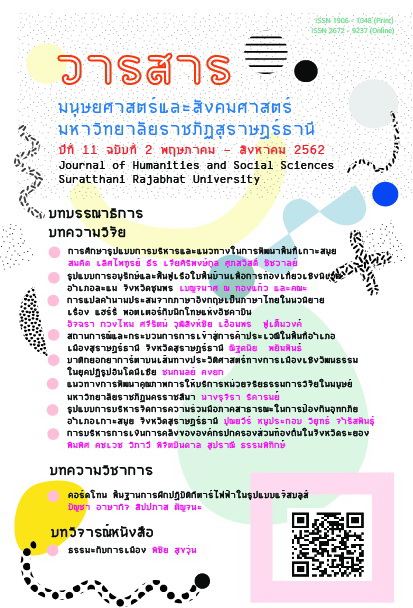การสื่อสารข้ามวัฒนธรรมผ่านการแปลคำนามประสมจากภาษาอังกฤษเป็นภาษาไทยในนวนิยายเรื่อง แฮร์รี่ พอตเตอร์กับนักโทษแห่งอัซคาบัน
Main Article Content
บทคัดย่อ
งานวิจัยนี้มีวัตถุประสงค์เพื่อศึกษากลวิธีการแปลคำนามประสมจากภาษาอังกฤษเป็นภาษาไทย โดยข้อมูลที่ใช้ในการศึกษาเป็นคำนามประสมและคู่แปลที่ปรากฏในนวนิยายภาษาอังกฤษ เรื่อง “Harry Potter and the Prisoner of Azkaban” แต่งโดย J.K. Rowling และในฉบับแปลภาษาไทยเรื่อง “แฮร์รี่ พอตเตอร์กับนักโทษแห่งอัซคาบัน” แปลโดย วลีพร หวังซื่อกุล ผลการวิจัยพบว่า พบคำนามประสมภาษาอังกฤษ จำนวน 1,540 คำ ปรากฏในนวนิยายภาษาอังกฤษ ซึ่งในการแปลคำนามประสมจากภาษาอังกฤษเป็นภาษาไทยที่ปรากฏในนวนิยายฉบับแปลนั้น พบประเภทของคำนามประสมใน ภาษาแปล จำนวน 8 ประเภท ประเภทของคำนามประสมในภาษาแปลที่ผู้แปลใช้มากที่สุด 3 ลำดับแรก ได้แก่ (1) นามวลี ร้อยละ 47.01 (2) คำนามประสม ร้อยละ 37.66 และ (3) ประโยค ร้อยละ 6.36 ตามลำดับ ส่วนกลวิธีการแปลคำนามประสมจากภาษาอังกฤษเป็นภาษาไทยนั้นพบว่า ผู้แปลใช้กลวิธีการแปล จำนวน 20 กลวิธี โดยกลวิธีการแปลที่ ผู้แปลใช้มากที่สุด 3 ลำดับแรก ได้แก่ (1) การแปลโดยการสร้างคำประสมใหม่ในภาษาไทยโดยแปลคำในภาษาต้นฉบับแบบตรงตัว ร้อยละ 20.58 (2) การแปลโดยการแทนที่ด้วยวลีหรือประโยคที่ปรากฏในวัฒนธรรมของภาษาแปล ร้อยละ 18.05 และ (3) การแปลโดย การใช้คำซึ่งเป็นที่รู้จักกันดีในภาษาไทย ร้อยละ 13.38 ตามลำดับ
Article Details

อนุญาตภายใต้เงื่อนไข Creative Commons Attribution-NonCommercial-NoDerivatives 4.0 International License.
ต้นฉบับทุกเรื่องที่พิมพ์เผยแพร่ได้รับการตรวจสอบความถูกต้องทางวิชาการโดยผู้ทรงคุณวุฒิ (Peer Peview) เฉพาะสาขามนุษยศาสตร์และสังคมศาสตร์ การตีพิมพ์บทความซ้ำต้องได้รับการอนุญาตจากกองบรรณาธิการเป็นลายลักษณ์อักษร
เอกสารอ้างอิง
Achara Thappang. (2013). The Communication of Compound Nouns through the Translation of English to Thai. Master’s Thesis,
Phitsanulok: Naresuan University. (In Thai)
Amara Prasithrathsint. (2004). The Revolution of Word Borrowing and Terminology in Thai Society. Journal of Arts, 33(1), 207-209. (In Thai)
Anong Iangubol. (1984). An Analytical Study of Compound Words in Thai. Journal of Thai Language and Literature, 1(2), 56-62. (In Thai)
Baker, M. (1992). In Other Words: A Coursebook on Translation. London and New York: Routledge.
Barnwell, K. (1980). Introduction to Semantics and Translation. England: Summer Institute of Linguistics.
Beekman, J. & Callow, J. (1974). Translating the Word of God. Michigan: Zondervan.
Benjama Boonterm. (2008). A Study of Interjection Translation in Harry Potter and the Order of the Phoenix and Harry Potter and the
Half-Blood Prince. Master’s Thesis, Nakhonpathom: Mahidol University. (In Thai)
Chaluai Boonprasert. (2010). Introduction to Linguistics (4thed.). Bangkok: Dhonburi Rajabhat University. (In Thai)
Downing, P. (1977). On the Creation and Use of English NominalCompounds. Language, 53(4), 810-842.
Levi, J.N. (1978). The Syntax and Semantics of Complex Nominals. New York: Academic Press.
Rowling, J.K. (1999). Harry Potter and the Prisoner of Azkaban. United States: Scholastic.
Rowling, J.K. (2007). Harry Potter and the Prisoner of Azkaban. Translated by Waleeporn Wangsuekul. Bangkok: Nanmee books Publications. (InThai)
Sanchawi Saibua. (2007). Principles of Translation (8th ed.). Bangkok: Thammasat University Press. (In Thai)
Supannee Pinmanee. (2006). Advanced Translation (3rd ed.). Bangkok: Chulalongkorn University Press. (In Thai)
The Royal Institute of Thailand. (2003). Thai Dictionary by the Royal Institute 2003. Bangkok: Nanmee books Publications. (In Thai)
Unchalee Singnoi. (2005). Compound Nouns: Science and Art for Thai Word formation. Bangkok: Chulalongkorn University Press. (In Thai)
Unchalee Singnoi. (2006). Eating Terms: What the Category Reveals about the Thai Mind. MANUSYA: Journal of Humanities, 9(1), 82-109.
Upakit-Silapasan, Phraya (Nim Kanchanachiwa). (1996). Lak phasa Thai (Principles of the Thai Language). Bangkok: Thai Wattana Panich Press. (In Thai)
Wilaiwan Khanittanan. (1987). Compound Words: Meanings. Journal of Language and Linguistics, 5(2), 91-100. (In Thai)


